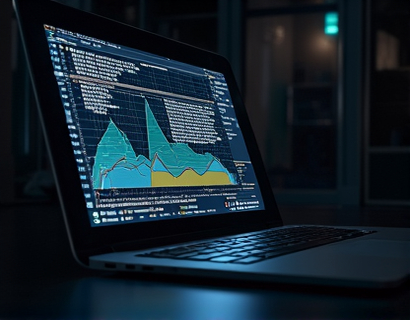Unlocking Tokenization: Leveraging Advanced Smart Contracts for UCASH and U Assets Management
In the rapidly evolving landscape of digital finance, tokenization has emerged as a transformative force, offering unprecedented opportunities for asset management and investment. This article delves into the intricacies of utilizing advanced smart contracts to create and manage tokens that are securely and efficiently pegged to leading cryptocurrencies and digital assets, specifically focusing on UCASH and other U assets. By harnessing the power of smart contract technology, financial ecosystems can achieve a new level of security, performance, and innovation.
Understanding Tokenization
Tokenization refers to the process of converting rights to an asset into a digital token on a blockchain. These tokens can represent a wide range of assets, from real estate and commodities to cryptocurrencies and utility tokens. The key advantage of tokenization lies in its ability to fractionalize assets, making them more accessible to a broader audience. In the context of UCASH and U assets, tokenization enables the creation of tokens that maintain a stable value by being pegged to these assets, thus providing a stable store of value and a means of exchange.
Smart Contracts: The Backbone of Tokenization
Smart contracts are self-executing contracts with the terms of the agreement directly written into code. They run on blockchain networks, ensuring transparency, immutability, and automation. In the realm of tokenization, smart contracts play a crucial role by automating the creation, management, and redemption of tokens. For UCASH and U assets, advanced smart contracts can ensure that tokens remain pegged to the underlying asset's value, adjusting automatically in response to market fluctuations.
Key Features of Smart Contracts for Tokenization
- Automated Token Issuance: Smart contracts can automatically issue tokens when certain conditions are met, such as the deposit of the underlying asset.
- Peg Maintenance: Advanced algorithms within the smart contract continuously monitor the value of the underlying asset and adjust the token supply to maintain the peg.
- Redemption Mechanisms: Users can redeem tokens for the underlying asset or other tokens, with the smart contract handling the transaction seamlessly.
- Transparency and Trust: All transactions and contract states are recorded on the blockchain, providing an auditable and trustworthy system.
Enhancing Security with Smart Contracts
Security is paramount in financial transactions, and smart contracts offer robust mechanisms to safeguard assets. By deploying smart contracts on secure blockchain platforms, the risk of fraud and manipulation is significantly reduced. The immutable nature of blockchain ensures that once a transaction is recorded, it cannot be altered, providing a high level of trust and security. Additionally, smart contracts can incorporate multi-signature requirements and other security protocols to further enhance protection.
Common Security Features
- Multi-Signature Wallets: Requires multiple approvals for critical transactions, reducing the risk of unauthorized access.
- Audit Trails: Every transaction is recorded and can be traced, making it easier to detect and prevent fraudulent activities.
- Bug Bounties: Encouraging the blockchain community to identify and fix vulnerabilities in the smart contract code.
- Regular Audits: Independent security audits to ensure the smart contract code is free from vulnerabilities.
Optimizing Performance with Efficient Smart Contracts
Performance is another critical aspect of tokenization, especially when dealing with high-frequency transactions and large volumes of data. Advanced smart contracts are designed to optimize performance by minimizing gas costs, reducing latency, and ensuring scalability. For UCASH and U assets, this means that token transactions can be executed swiftly and efficiently, even during periods of high market activity.
Performance Optimization Techniques
- Gas Optimization: Writing smart contracts that use the least amount of computational resources, reducing transaction costs.
- Layer 2 Solutions: Utilizing off-chain transactions to handle high-volume operations, with final settlement on the blockchain.
- Sharding: Dividing the blockchain into smaller, more manageable parts to improve processing speed and capacity.
- Caching Mechanisms: Storing frequently accessed data locally to reduce the need for repeated blockchain queries.
Pegging Tokens to UCASH and Other U Assets
Pegging tokens to UCASH or other U assets involves creating a stablecoin-like token that maintains a fixed value relative to the underlying asset. This is achieved through a combination of smart contract design and economic mechanisms. For UCASH, which is a stablecoin pegged to the US dollar, the smart contract ensures that the token supply adjusts in real-time to maintain the peg, even as the value of the US dollar fluctuates.
Mechanisms for Pegging
- Overcollateralization: Holding more value in the underlying asset than the total value of the tokens issued, providing a buffer against market volatility.
- Automated Market Making: Smart contracts can act as market makers, buying and selling tokens to maintain the peg.
- Feed Mechanisms: Integrating with external data feeds to get real-time asset prices, ensuring the smart contract can make informed adjustments.
- Penalty and Reward Systems: Implementing mechanisms to incentivize behavior that supports the maintenance of the peg.
Benefits of Tokenizing UCASH and U Assets
Tokenizing UCASH and other U assets through advanced smart contracts offers numerous benefits, making it an attractive solution for both issuers and investors. Some of the key advantages include:
- Increased Liquidity: Tokens can be traded on various exchanges, providing liquidity to investors and enhancing market efficiency. <
- Accessibility: Fractional ownership allows more individuals to participate in the market, democratizing access to high-value assets.
- Transparency: All transactions and contract states are visible on the blockchain, building trust and reducing the risk of fraud.
- Cost Efficiency: Smart contracts reduce the need for intermediaries, lowering transaction costs and increasing efficiency.
- Global Reach: Digital tokens can be traded 24/7, accessible to a global audience without geographical restrictions.
Case Studies and Real-World Applications
Several projects have successfully implemented tokenization using advanced smart contracts to manage UCASH and other U assets. These case studies demonstrate the practical applications and benefits of this approach.
Case Study 1: StableToken Project
The StableToken project tokenized a digital asset pegged to the US dollar, using a smart contract that maintained a 1:1 ratio. The project utilized overcollateralization and automated market making to ensure the peg's stability. The result was a highly liquid and trustworthy token that attracted a wide range of investors.
Case Study 2: UAsset Platform
UAsset Platform allowed users to tokenize various digital assets, including cryptocurrencies and NFTs, and peg them to UCASH. The platform's smart contracts automatically adjusted the token supply to maintain the peg, providing users with a secure and efficient way to manage their assets.
Future Trends and Innovations
The future of tokenization and smart contract technology is promising, with several trends and innovations on the horizon. These developments will further enhance the capabilities and adoption of tokenized assets.
Decentralized Finance (DeFi) Integration
Integrating tokenized assets with DeFi protocols can unlock new possibilities for lending, borrowing, and yield farming. Smart contracts can automate these processes, providing users with greater flexibility and control over their assets.
Cross-Chain Interoperability
As blockchain ecosystems become more interconnected, cross-chain solutions will enable tokenized assets to be used across different platforms. This will enhance liquidity and accessibility, creating a more unified financial ecosystem.
Advanced Oracle Solutions
Oracles play a crucial role in providing real-time data to smart contracts. Advanced oracle solutions will improve the accuracy and reliability of data feeds, further enhancing the performance of pegged tokens.
Conclusion
Tokenization, powered by advanced smart contracts, represents a significant leap forward in digital asset management. By leveraging the security, efficiency, and innovation of blockchain technology, UCASH and other U assets can be managed in a way that enhances value and accessibility. As the technology continues to evolve, the potential for tokenization to transform financial ecosystems becomes increasingly evident. Embracing these advancements can provide a competitive edge and open new avenues for growth and investment.










































